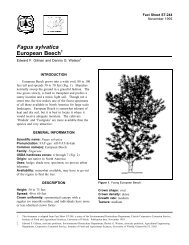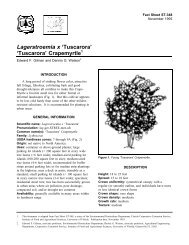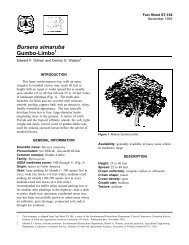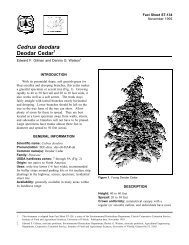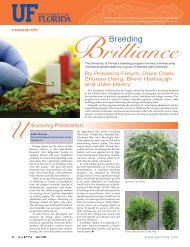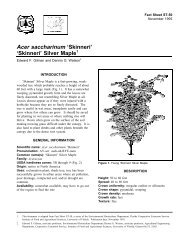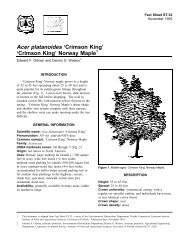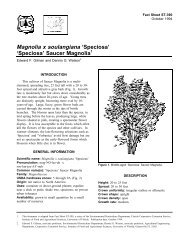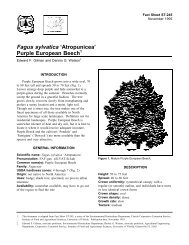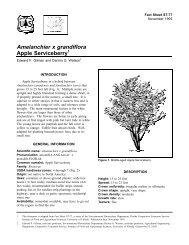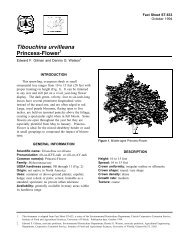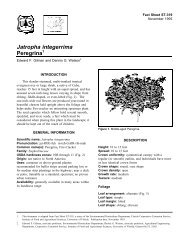'Redspire' Callery Pear - Environmental Horticulture - University of ...
'Redspire' Callery Pear - Environmental Horticulture - University of ...
'Redspire' Callery Pear - Environmental Horticulture - University of ...
Create successful ePaper yourself
Turn your PDF publications into a flip-book with our unique Google optimized e-Paper software.
Pyrus calleryana ‘Redspire’<br />
‘Redspire’ <strong>Callery</strong> <strong>Pear</strong> 1<br />
Edward F. Gilman and Dennis G. Watson 2<br />
INTRODUCTION<br />
‘Redspire’ <strong>Callery</strong> <strong>Pear</strong> quickly grows 35 to 45<br />
feet high and 20 feet wide, with upright-spreading,<br />
thornless branches (Fig. 1). The narrow crown enable<br />
this tree to be used in tight overhead spaces. The<br />
silhouette appears as a fat column growing wider than<br />
‘Whitehouse’ and ‘Capital’ but narrower than<br />
‘Bradford’ and ‘Aristocrat’. In spring before the new<br />
leaves unfold, the tree puts on a nice display <strong>of</strong> pure<br />
white flowers larger than ‘Bradford’ or ‘Aristocrat’.<br />
Flowering may be subdued in USDA hardiness zone<br />
8b and it occurs at about the same time as ‘Bradford’<br />
<strong>Callery</strong> <strong>Pear</strong>. The leaves emerge as red/purple, then<br />
become 1.5 to 3 inches long, glossy green with wavy<br />
margins and a red blush. They turn yellow to orange<br />
in fall in the south putting on an attractive display<br />
before dropping. Fall color may be subdued in the<br />
north. The small, pea-sized, red/brown fruits which<br />
form are quite attractive to birds and other wildlife,<br />
and mummify on the tree persisting for several months<br />
to a year. Planting two or more cultivars <strong>of</strong> <strong>Callery</strong><br />
<strong>Pear</strong> together could increase fruit set.<br />
GENERAL INFORMATION<br />
Scientific name: Pyrus calleryana ‘Redspire’<br />
Pronunciation: PIE-rus kal-ler-ee-AY-nuh<br />
Common name(s): ‘Redspire’ <strong>Callery</strong> <strong>Pear</strong><br />
Family: Rosaceae<br />
USDA hardiness zones: 5 through 9A (Fig. 2)<br />
Origin: not native to North America<br />
Uses: container or above-ground planter; large<br />
parking lot islands (> 200 square feet in size); wide<br />
tree lawns (>6 feet wide); medium-sized parking lot<br />
Figure 1. Young ‘Redspire’ <strong>Callery</strong> <strong>Pear</strong>.<br />
Fact Sheet ST-538<br />
October 1994<br />
islands (100-200 square feet in size); medium-sized<br />
tree lawns (4-6 feet wide); recommended for buffer<br />
strips around parking lots or for median strip plantings<br />
in the highway; screen; shade tree; small parking lot<br />
islands (< 100 square feet in size); narrow tree lawns<br />
(3-4 feet wide); specimen; sidewalk cutout (tree pit);<br />
residential street tree; tree has been successfully grown<br />
in urban areas where air pollution, poor drainage,<br />
1. This document is adapted from Fact Sheet ST-538, a series <strong>of</strong> the <strong>Environmental</strong> <strong>Horticulture</strong> Department, Florida Cooperative Extension Service,<br />
Institute <strong>of</strong> Food and Agricultural Sciences, <strong>University</strong> <strong>of</strong> Florida. Publication date: October 1994.<br />
2. Edward F. Gilman, associate pr<strong>of</strong>essor, <strong>Environmental</strong> <strong>Horticulture</strong> Department; Dennis G. Watson, associate pr<strong>of</strong>essor, Agricultural Engineering<br />
Department, Cooperative Extension Service, Institute <strong>of</strong> Food and Agricultural Sciences, <strong>University</strong> <strong>of</strong> Florida, Gainesville FL 32611.
Pyrus calleryana ‘Redspire’ -- ‘Redspire’ <strong>Callery</strong> <strong>Pear</strong> Page 2<br />
Figure 2. Shaded area represents potential planting range.<br />
compacted soil, and/or drought are common<br />
Availability: generally available in many areas within<br />
its hardiness range<br />
DESCRIPTION<br />
Height: 35 to 45 feet<br />
Spread: 20 to 30 feet<br />
Crown uniformity: symmetrical canopy with a<br />
regular (or smooth) outline, and individuals have more<br />
or less identical crown forms<br />
Crown shape: pyramidal<br />
Crown density: moderate<br />
Growth rate: fast<br />
Texture: medium<br />
Foliage<br />
Leaf arrangement: alternate (Fig. 3)<br />
Leaf type: simple<br />
Leaf margin: crenate; sinuate; undulate<br />
Leaf shape: ovate<br />
Leaf venation: pinnate; reticulate<br />
Leaf type and persistence: deciduous<br />
Leaf blade length: 2 to 4 inches; less than 2 inches<br />
Leaf color: green<br />
Fall color: orange; yellow<br />
Fall characteristic: showy<br />
Flower<br />
Flower color: white<br />
Flower characteristics: spring flowering; very<br />
showy<br />
Fruit<br />
Fruit shape: round<br />
Fruit length: < .5 inch<br />
Fruit covering: dry or hard<br />
Fruit color: brown; tan<br />
Fruit characteristics: attracts birds; attracts squirrels<br />
and other mammals; inconspicuous and not showy; no<br />
significant litter problem; persistent on the tree<br />
Trunk and Branches<br />
Trunk/bark/branches: bark is thin and easily<br />
damaged from mechanical impact; routinely grown<br />
with, or trainable to be grown with, multiple trunks;<br />
grow mostly upright and will not droop; not<br />
particularly showy; tree wants to grow with several
Pyrus calleryana ‘Redspire’ -- ‘Redspire’ <strong>Callery</strong> <strong>Pear</strong> Page 3<br />
Figure 3. Foliage <strong>of</strong> ‘Redspire’ <strong>Callery</strong> <strong>Pear</strong>.<br />
trunks but can be trained to grow with a single trunk;<br />
no thorns<br />
Pruning requirement: requires pruning to develop<br />
strong structure<br />
Breakage: resistant<br />
Current year twig color: brown<br />
Current year twig thickness: thick<br />
Culture<br />
Light requirement: tree grows in full sun<br />
Soil tolerances: clay; loam; sand; acidic;<br />
occasionally wet; alkaline; well-drained<br />
Drought tolerance: high<br />
Aerosol salt tolerance: moderate<br />
Soil salt tolerance: moderate<br />
Other<br />
Roots: surface roots are usually not a problem<br />
Winter interest: no special winter interest<br />
Outstanding tree: not particularly outstanding<br />
Invasive potential: little, if any, potential at this time<br />
Ozone sensitivity: tolerant<br />
Verticillium wilt susceptibility: not known to be<br />
susceptible<br />
Pest resistance: very sensitive to one or more pests<br />
or diseases which can affect tree health or aesthetics<br />
USE AND MANAGEMENT<br />
Planted commonly as a street tree or in parking lot<br />
islands, it is also quite suited for downtown tree pits<br />
due to its urban tolerance. Like ‘Bradford’ pear, it is<br />
able to tolerate small soil spaces. It looks great<br />
located along a street on 20 to 25-foot-centers and<br />
creates a ‘corridor’ for traffic flow.<br />
Fire blight susceptibility was light to moderate in<br />
tests conducted at Auburn <strong>University</strong>. Others report<br />
resistance to fireblight. It has a fruit set which could<br />
create a nuisance for some. Pruning the trees early in<br />
their life to space lateral branches along a central trunk<br />
should help in developing a strong, well-structured<br />
tree. Only buy trees with well-spaced branches. This<br />
cultivar has a better form than ‘Bradford’ and is easier<br />
to train to a strong structure.<br />
<strong>Callery</strong> <strong>Pear</strong> trees are shallow-rooted and will<br />
tolerate most soil types including alkaline and clay, are<br />
pest- and pollution-resistant, and tolerate drought and<br />
wet soil well. It is a very adaptable tree suited for<br />
downtown and other restricted soil spaces.<br />
Pests<br />
Propagation is by cuttings.<br />
Aphids cause distorted growth and deposits <strong>of</strong><br />
honeydew.<br />
Scales occasionally affect pears.<br />
Several borers may attack pear. Keep trees<br />
healthy to prevent attacks.<br />
Diseases<br />
In tests conducted in Kentucky and Alabama,<br />
‘Redspire’ <strong>Callery</strong> <strong>Pear</strong> was light to moderately<br />
susceptible to fire blight. Tips <strong>of</strong> infected branches<br />
appear scorched and burnt. The leaves droop, turn<br />
brown, but remain hanging on the tree. The bacteria<br />
wash down the branch and form cankers. Bark inside<br />
the canker <strong>of</strong>ten shreds and peels. When a canker<br />
girdles a branch, that branch dies. Prune out infected<br />
branches well below the infected area.



